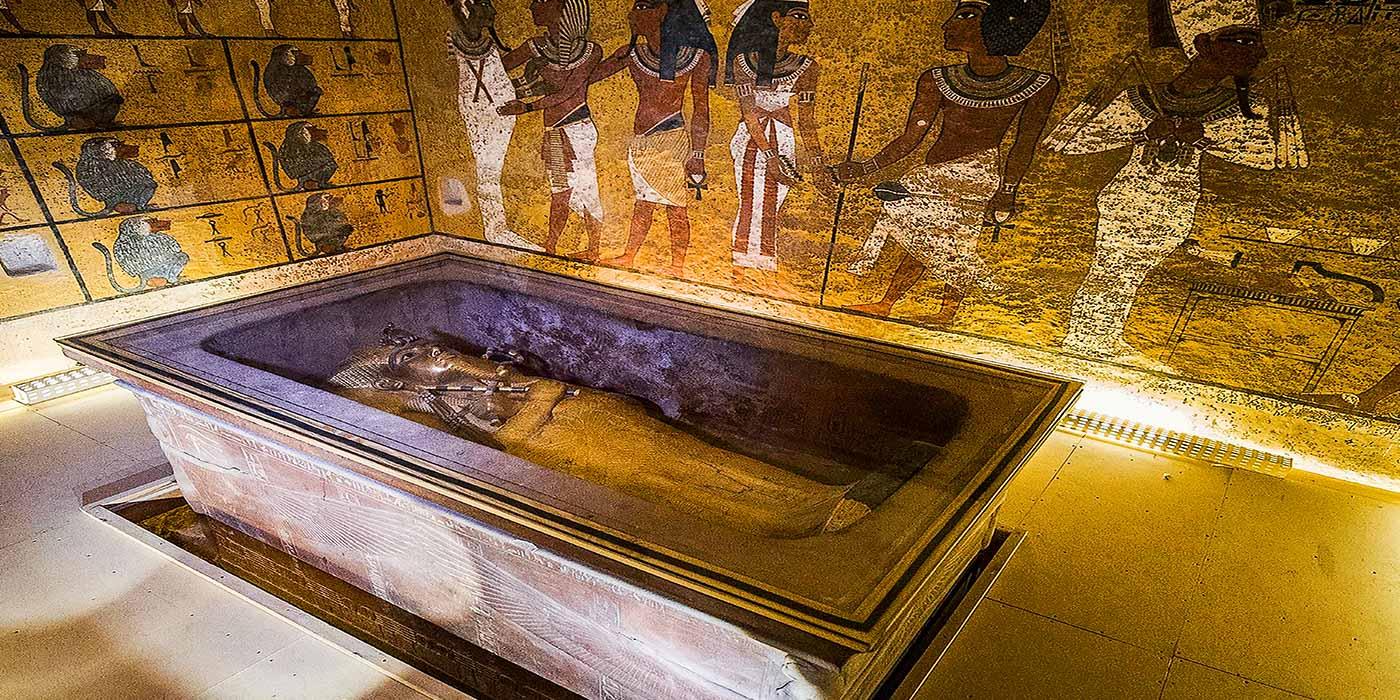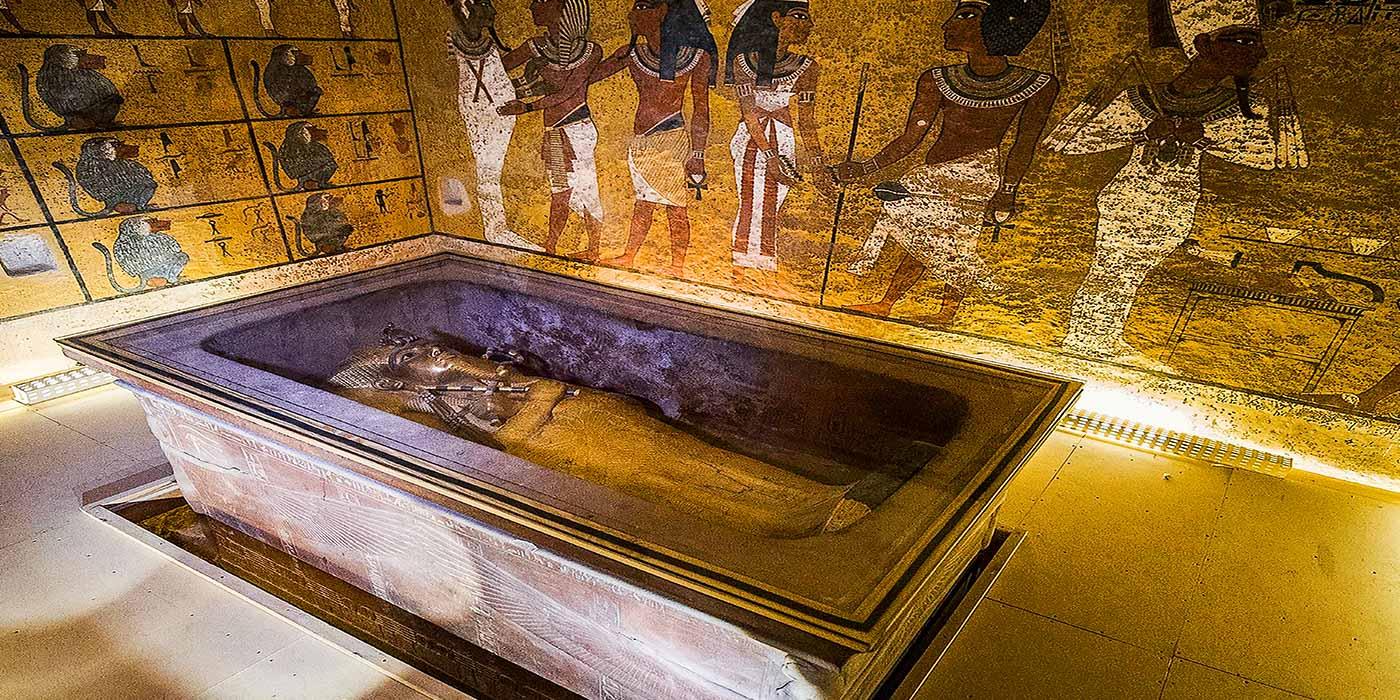
Tomb of Tutankhamun
In the 18th dynasty, a 9-year-old young boy King became Pharaoh starting in 1332 BC, a period of Egyptian history known as the New Kingdom. He was the grandson of the great pharaoh Amenhotep II, and the son of Akhenaten, an important figure in the history. The name ‘Tutankhamun’ derives from the meaning ‘Living Image of Amun.’ In 1922, the famous British Archaeologist Howard Carter and his team came across the nearly intact Tomb and Burial chamber of Tutankhamun which received worldwide attention due to the sheer nature and wonder of this rich ornate tombs and artifacts.
In the 18th Dynasty, a young Boy King became Pharaoh starting in 1332 BC, a period of Egyptian history known as the New Kingdom.The name ‘Tutankhamun’ derives from the meaning ‘Living Image of Amun’.In 1922, the then famous British Archaeologist Howard Carter and his team came across the nearly intact Tomb and Burial chamber of Tutankhamun which received worldwide attention due to the sheer nature wonder of this rich ornate Tombs and artifacts.
Location
Just a short 1-hour flight from Cairo or the night sleeper train from Cairo (approximately 10 hours) down to Luxor in Upper Egypt. It is also accessible from Hurghada by flight (30 minutes) or by road in roughly 4 hours. Options from Aswan by road (3 hours), or Nile cruise over a few days sailing.
How do you get to the tomb?
It’s just by a short 1-hour flight from Cairo or by the night sleeper train from Cairo (approximately 10 hours) down to Luxor in Upper Egypt. It is also accessible from Hurghada by flight (30 minutes) or by road in roughly 4 hours. Options from Aswan by road (3 hours), or onboard a Nile cruise over a few days sailing.
Who discovered the Tomb? And how?
Situated on the West Bank of Luxor across the Nile, Tomb of Tutankhamun is considered one of the best-preserved royal tombs ever discovered. Hidden for over 3000 years, this tomb miraculously survived flooding from the Nile and tomb robbers which were common throughout the centuries. Whilst it was the British Egyptologist Howard Carter who finally found the Tomb, it was initially brought to light by an American businessman, Mr. Theodore Davis who discovered items leading to the Tomb. Although Lord Carnarvon had informed Mr. Carter that he will stop funding the digging process, Carter insisted that he will find something great this time and that was already after 5 years of fruitless work.The discovery of these items and then further excavations close by, led Mr. Carter to believe that there was a huge discovery to be found nearby. A small pit close by the Tomb area was discovered with many items such as embalming materials, gold foil linen bags and broken pottery.
When the Tomb was actually discovered, there were several dignitaries present along with Carter including Lady Evelyn Herbert, Lord Carnarvon and Calendar his assistant. After previously digging near to Ramses IV’s Tomb, they had found a workman’s hut close by. On removing this hut, it revealed a step, which was to be the pivotal discovery of the main door to the Tomb, dating 4th of November 1922.
Initially, Carter drilled a small hole large enough to see through with the light of a candle, what he saw inside totally astounded him. Reflections of brilliant gold flashed back at him. Very quickly, they drilled further to create a space big enough to squeeze through. On entering, they climbed down into a room and were taken aback by the beautiful carved golden furnishings and objects that he described as ‘wonderful things’ and they lead him to further rooms and additional artifacts.
The Tomb had previously been robbed, however and fortunately, the majority of important artifacts still remained. Over time, the successors of Tutankhamun had tried to swipe his name away out of history, that’s likely why the most important contents of his tomb and treasures have not been robbed by tomb robbers. Experts say that we could have lost this entire king’s history without this tomb discovery since he has no temples or battles during his short reign.

What’s inside?
The chamber of King Tut’s tomb is full of magical decorations that show parts of his funeral, with no carvings comparing to the rest of the royal tombs in the Valley of Kings. The rest of the tomb is left bare, with no paintings, the thing that experts find very unusual to a royal tomb. There is a way less of the religious texts written all along the tomb’s walls. This led to an assumption that this tomb was meant to be finished quickly and that increases the suspicions about the reason of death which is still unclear so far.
Inside the tomb, more than 700 items have been found. They have found beds, coaches, chairs, statutes, musical instruments, weapons, Chariot, jewelry, clothes, food, daggers, shields, and cosmetics that should accompany him into the afterlife. It took Carter’s team 3 months to clear the room of all its contents and later these contents were moved to an exhibition in the Egyptian Museum called “Treasures of Tutankhamun.” There were three coffins that have been found in King Tut’s sarcophagus. The inner one is made of solid gold and was originally covered by a black thick layer that has been removed later by Carter’s team to leave us with the magnificent gold coffin we see now in the Egyptian Museum. The two outer coffins with made of wood and covered with gold as well. They found two figure statues that should lead to the chamber of the mummy of the king. Another masterpiece that made this tomb more famous for is King Tut's funerary golden mask. It is considered to be one of the best pieces of art found in the world. It is made of solid gold as well; however, one can see the life inside the eyes of the silent dead face due its high craft. It is colored in gold and blue as a representation of the sun and the sky since the king in the Egyptian history was a symbol for the sun god Ra.
Some of the treasures have toured worldwide after the discovery starting in 1962. There were presented in the Louvre Museum in Paris, Kyoto Municipal Museum of Art in Tokyo, the United States, Canada, and Germany. These international exhibitions have attracted millions of visitors from all nationalities to see the marvelous antiquities.
The tomb has turned Tut from a child minor pharaoh back in his time to one of the most celebrated kings in the ancient history. Today, the Sarcophagus and Golden figured Head of the Boy King sits proudly in the Egyptian Museum of Antiquities in Cairo and was famously viewed and photographed with Princess Diana before her death.
